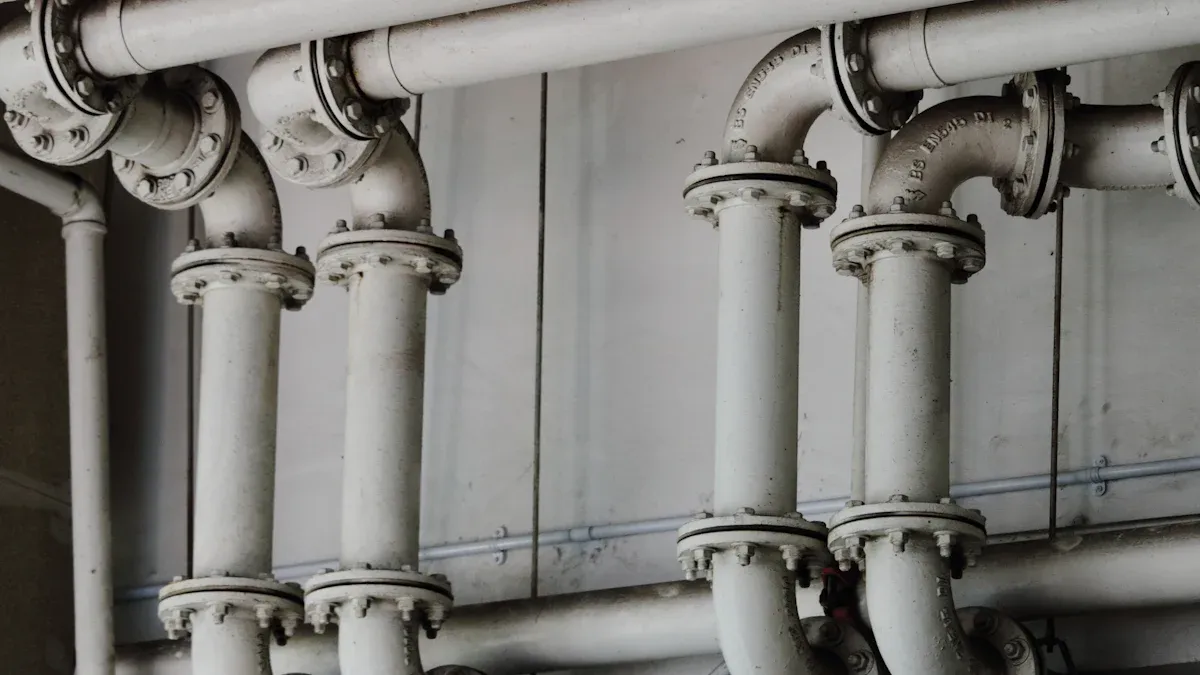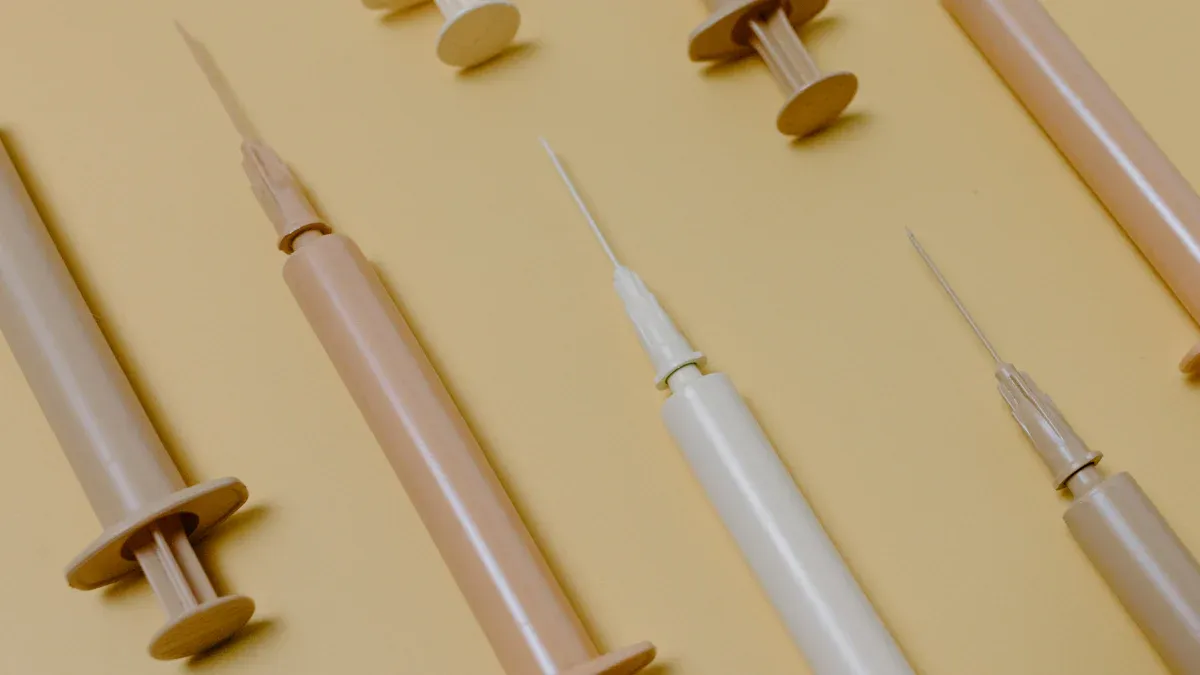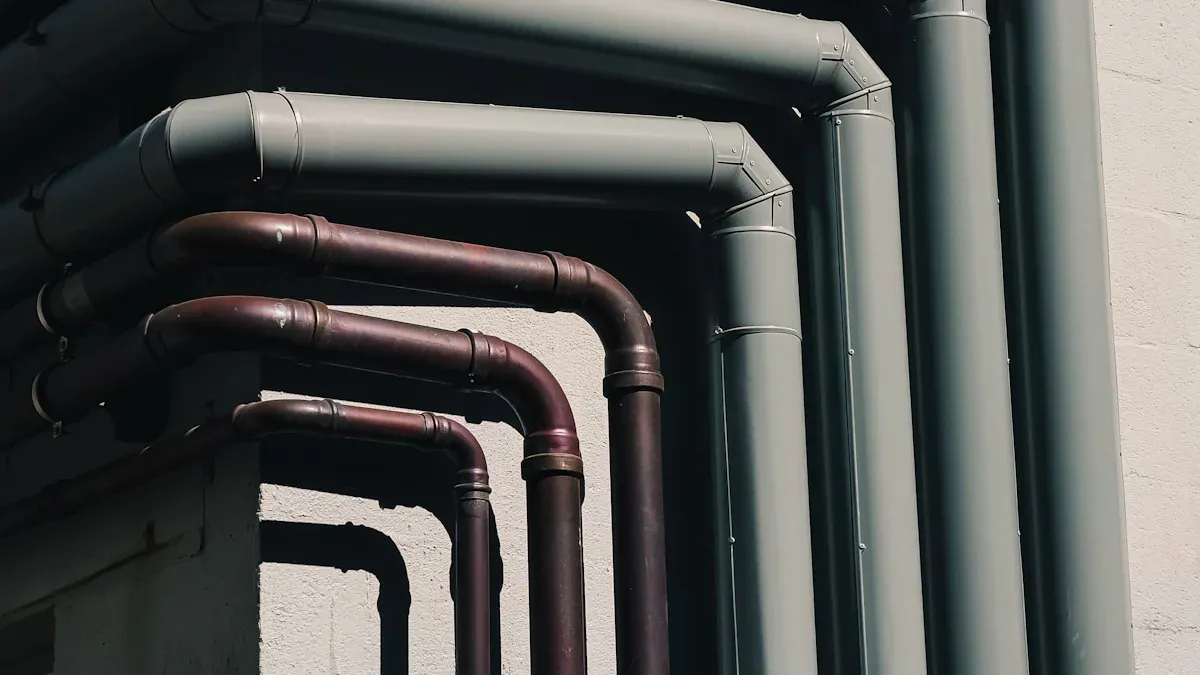The Ultimate Guide to Polyimide Tubing Selection for Professionals

Choosing the right polyimide tubing with high tensile strength is crucial for achieving excellent results in professional work. A helpful guide can ensure you meet industry requirements while keeping your operations running smoothly. The market for polyimide-filled PTFE tubes is expanding rapidly, growing by more than 5% each year. This trend indicates that more industries are seeking strong and flexible materials. It's essential to consider how polyimide tubing performs in challenging conditions and verify that it complies with regulations to avoid significant errors. Polyimide tubing is not only very strong but also durable, making it ideal for critical applications.
Key Takeaways
Pick polyimide tubing based on where it will be used. Think about heat, water, and chemicals to make sure it works well.
Follow rules for safety. Choose tubing that meets FDA and REACH standards for safe and reliable use.
Check the tubing's strength and flexibility. Make sure it is strong and bends easily for your project needs.
Focus on heat resistance. Polyimide tubing can handle heat up to 400°C, so it’s great for hot places like factories or airplanes.
Get the right size and thickness. Measure carefully to make sure the tubing fits and works safely under pressure.
Understanding Application Needs
Environmental Conditions and Challenges
Think about the environment the tubing will face. Hot or cold temperatures, wet areas, or chemicals can change how it works. For example, hot places need tubing that handles heat well. If it will touch water or harsh chemicals, it must resist damage. Knowing these problems helps you pick tubing that works well.
Physical Demands and Stress Factors
Polyimide tubing often faces bending or stretching. It needs to be strong and flexible. Thin tubing is good for small tasks but must handle pressure. Check the thickness and strength to match your job. Factories may need thicker tubing for high pressure. Medical tools need light, bendable tubing for comfort.
Industry Rules and Safety Standards
Following rules is important when picking tubing. Medical tubing must meet FDA and IEC 60601-1 rules for safety. It should resist heat, work with cleaning, and be safe for the body. Breaking rules can cause big problems. REACH and EU MDR rules ensure good materials for medical use. Companies like Zeus test their tubing to meet these rules. Always choose tubing that follows these rules to stay safe and professional.
Exploring Polyimide Tubing Properties

Heat Resistance and High-Temperature Uses
Polyimide tubing is great at handling high heat. It works well in temperatures up to 400°C, better than PTFE or PFA tubing. This makes it perfect for hot places like aerospace industries.
Property | Polyimide Tubing | PTFE/PFA Tubing |
|---|---|---|
High-Temperature Resistance | Up to 400°C | Lower than polyimide |
Studies show polyimide tubing stays strong in high heat. For example, a PMDA-ODA mix with 1% SWCNT loses 5% weight at 566.0°C. This strength helps it work in tough jobs like heating systems or engines.
Matrix Type | Temperature of 5% Weight Loss | Temperature of 10% Weight Loss |
|---|---|---|
PMDA-ODA with 1% SWCNT | 566.0ºC | N/A |
Poly-oxydiphenylene-pyromellitimide with 20% silicon carbide | 569.7ºC | N/A |
Electrical Insulation and High-Voltage Safety
Polyimide tubing is great for stopping electricity from passing through. It works well in high-voltage systems. Tests show it stays strong even in tough conditions. For example:
A 12-hour flame test showed it kept its insulation.
RP46 pipes handled 2100-2300°F, showing fire resistance.
ASTM D495 tests showed 130 seconds of arc resistance.
These tests prove polyimide tubing is good for power systems. It also resists water and chemicals, making it last longer.
Thin Walls and Precision for Special Jobs
Polyimide tubing is very precise and has thin walls. This makes it useful for special tools in medicine, aerospace, and semiconductors. For example, surgical tools need tubing under 0.5 mm wide with ±0.02 mm accuracy.
Microfluidic devices need tubing with 100 μm width and 20 μm walls.
Medical tubing has a smooth surface (Ra ≤0.8 μm) to stop bacteria.
These features help polyimide tubing meet strict needs for advanced technology. It ensures accuracy and works well in every job.
Key Selection Criteria for Polyimide Tubing
Temperature Resistance and Stability
When picking polyimide tubing, heat resistance is very important. Strong tubing stays solid even in extreme heat. It can handle up to 400°C, perfect for hot places like factories or airplanes. The tubing stays stable over time, even with changing temperatures.
Measurable Criteria | Description |
|---|---|
Electrical Properties | Includes how well it resists electricity, even with heat. |
Mechanical Properties | Strength and flexibility change with heat and environment. |
Environmental Resistance | Fights damage from dirt, heat, and electric sparks. |
Thermal Stability | Stays strong in different temperatures, great for tough jobs. |
This table shows what affects tubing in hot conditions. Knowing these helps you pick the right tubing.
Chemical Compatibility for Diverse Environments
Polyimide tubing often touches strong chemicals, so it must resist damage. It should not break down when near acids or solvents. A rating system shows how well it works with chemicals:
Compatibility Rating | Description |
|---|---|
A | Excellent - No damage, stays strong. |
B | Good - Small changes, still works well. |
C | Fair - Some damage, shorter life. |
D | Poor - Breaks quickly, not safe. |
N/A | Unknown - Needs more testing. |
For medical or factory use, pick "A" or "B" rated tubing. This keeps it safe and strong in tough chemical areas.
Flexibility, Durability, and High Tensile Strength
Tubing needs to bend and last long for many uses. Strong polyimide tubing stretches without breaking and resists wear. This makes it great for medical tools or electronics.
Criteria | Statistics |
|---|---|
Tensile Strength: | 172 N/mm² Minimum |
Elongation @ Break: | 70% Nominal |
Radiation Resistance: | 3.0 x 10⁷ Gamma Dose Gy |
Dielectric Strength: | 157.5 V/μm Minimum |
These features help tubing handle stress and stay strong. Flexible tubing fits tight spaces and works in tricky designs. Whether for machines or medical tools, it stays reliable and tough.
Size, Wall Thickness, and Pressure Ratings
When choosing polyimide tubing, size and strength matter a lot. These features help the tubing work well and stay strong.
The tubing's size includes its inside (ID) and outside (OD) widths. It must match your needs. Common ID sizes range from 0.004″ to 0.086″ (0.10mm to 2.18mm). This makes it useful for tiny or bigger tasks. Wall thickness affects how bendy and strong it is. It usually ranges from 0.0005″ to 0.008″ (0.0127mm to 0.2032mm). For accuracy, ID sizes over 0.0200″ have a ±1% tolerance. Smaller IDs have a ±0.0002″ tolerance. Wall thickness tolerances are strict too, ensuring steady performance.
Measurement Type | Specification Range |
|---|---|
Standard ID Sizes | 0.004″ to 0.086″ (0.10mm to 2.18mm) |
Wall Thickness | 0.0005″ to 0.008″ (0.0127mm to 0.2032mm) |
ID Tolerance | ± 1% of Nominal (ID > 0.0200″) |
± 0.0002″ (ID < 0.0200″) | |
Wall Thickness Tolerance | ±0.00025″ (Wall > 0.0010″) |
+0.00025″, – 0″ (Wall < 0.0010″) |
Pressure ratings show how much force the tubing can handle. This includes tensile strength, hoop stress, and burst strength. Polyimide tubing has at least 20,000 PSI tensile strength and 11,000 PSI hoop stress. Burst strength depends on wall thickness and OD radius. It is calculated as (Hoop Stress x Wall Thickness)/OD Radius. These features make the tubing safe for high-pressure jobs.
By knowing these details, you can pick tubing that fits your needs and works safely.
Industry Applications of Polyimide Tubing

Medical Uses and Patient Safety
Polyimide tubing is important in today’s healthcare. Its thin design and accuracy make it great for small surgeries. It is used in catheters, endoscopes, and flexible medical tools. These tools need to be safe and work well with the body. The tubing’s smooth surface stops bacteria from growing, keeping patients safe. It can also handle cleaning and sterilizing, so it can be reused without losing quality.
Aerospace and Defense Uses
In planes and defense, polyimide tubing is very useful. It handles high heat and stays strong in tough conditions. This makes it perfect for engines and space systems. Smaller parts are needed in these fields, so this tubing is in high demand. It is light and manages heat well, making it great for advanced machines.
Key Factors | Problems |
|---|---|
Growing need in aerospace and defense | High costs to make polyimide materials |
Demand for smaller electronic parts | Not enough raw materials for production |
Need for better heat control | Cheaper materials competing in the market |
Even with problems like high costs and material shortages, polyimide tubing is still the best choice. It handles high electricity and tough environments, making it reliable for defense work.
Electronics and Electrical Engineering
Polyimide tubing is key in electronics and electrical work. It stops electricity from causing damage to parts. It is used in high-voltage systems, circuit boards, and wiring. Its thin walls save space, which is important for modern devices. It also resists chemicals and water, so it lasts a long time, even in hard conditions.
Industrial and Automotive Applications
Polyimide tubing is important in factories and cars. It handles heat and resists damage, making it very dependable. It is used in machines, car sensors, and electric vehicle parts.
Electric cars need strong materials for tough conditions. Polyimide tubing works well because it insulates and lasts long. It is also found in transformers and circuit testers, keeping systems running smoothly.
Smaller electronics need tiny, strong parts. Polyimide tubing is thin but strong, fitting these needs perfectly. It keeps working well even when made smaller.
Factories need materials that resist heat and chemicals. Polyimide tubing is great for these jobs. It works well in hot and harsh places, making it a top choice.
Using polyimide tubing helps systems work better and last longer. Its strength and flexibility make it useful for many factory and car tasks.
Addressing Common Concerns in Polyimide Tubing Selection
Cost and Budget Considerations
Picking polyimide tubing means balancing cost and quality. Good tubing might cost more at first but saves money later. Strong materials last longer, so you replace them less often. This lowers costs and boosts profits for many industries.
nsuring Regulatory Compliance (e.g., RoHS, REACH)
Following rules is key when picking polyimide tubing. It keeps products safe and accepted in the market. For example, RoHS limits harmful materials, and REACH ensures chemical safety. In healthcare, FDA rules make sure tubing is safe for patients.
Here’s a table of important rules and why they matter for tubing:
Regulatory Standard | Relevance to Polyimide Tubing |
|---|---|
REACH | Ensures chemical safety |
RoHS | Limits harmful substances |
FDA | Sets rules for medical and food-safe tubing |
Knowing these rules helps you avoid problems and meet industry needs.
Choosing Reliable Manufacturers and Suppliers
Picking a good manufacturer is as important as the tubing itself. Trusted suppliers give clear details and meet your needs. They also follow standards like ISO 9001 for quality control.
Check reviews and case studies to learn about their products. Good suppliers also offer help with setup and use. Working with a reliable company ensures your tubing works well and lasts long.
Knowing what your project needs is very important. Think about things like safety for the body, resistance to chemicals, and how it works in different situations. Picking the right tubing keeps it safe and works best.
Polyimide tubing is special because it handles heat, is precise, and lasts long. These features make it useful in healthcare, airplanes, and electronics.
Choosing wisely helps the tubing work well and follow rules. This ensures success and safety for your projects over time.
FAQ
What makes polyimide tubing special compared to other materials?
Polyimide tubing is unique because it handles heat very well. It has thin walls and lasts a long time. Unlike PTFE or PFA, it works in tough conditions. It resists high temperatures and chemicals, making it great for special uses.
Can polyimide tubing be used in medical tools?
Yes, polyimide tubing is common in medical tools. Its smooth surface stops bacteria from growing, keeping patients safe. It follows strict rules like FDA and ISO standards. This makes it perfect for catheters, endoscopes, and surgical tools.
How do you pick the right size for polyimide tubing?
To choose the right size, measure the inside (ID) and outside (OD) widths and wall thickness. Match these to your job’s needs. For high-pressure jobs, pick thicker walls. For precise tasks, use thinner walls with exact measurements.
Is polyimide tubing safe with strong chemicals?
Polyimide tubing can handle many strong chemicals like acids and solvents. Always check its chemical rating (A, B, C, or D) for your job. For factories or medical use, pick tubing rated “A” or “B” for safety and strength.
How do you make sure the tubing meets rules?
Buy tubing from trusted companies that follow rules like RoHS, REACH, and FDA. Look for certifications and test results. Good suppliers give clear proof their tubing meets safety and performance standards.
See Also
Comprehensive Overview of Medical-Grade FEP Tubing
Choosing FEP Autoclavable Heat Shrink Tubing Made Easy
Finding Ideal FEP Biocompatible Heat Shrink Tubing Solutions

